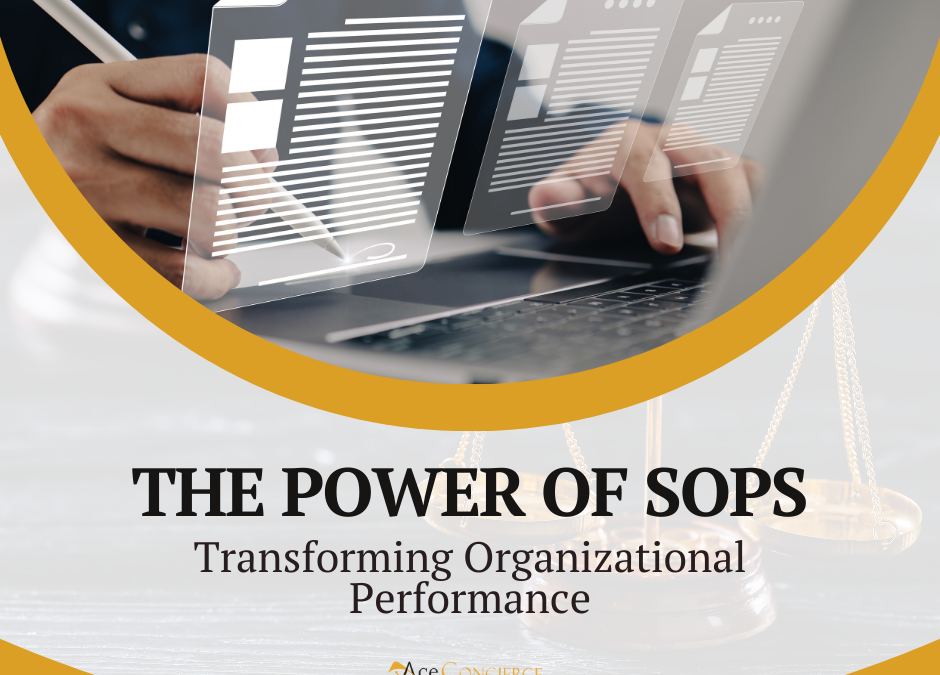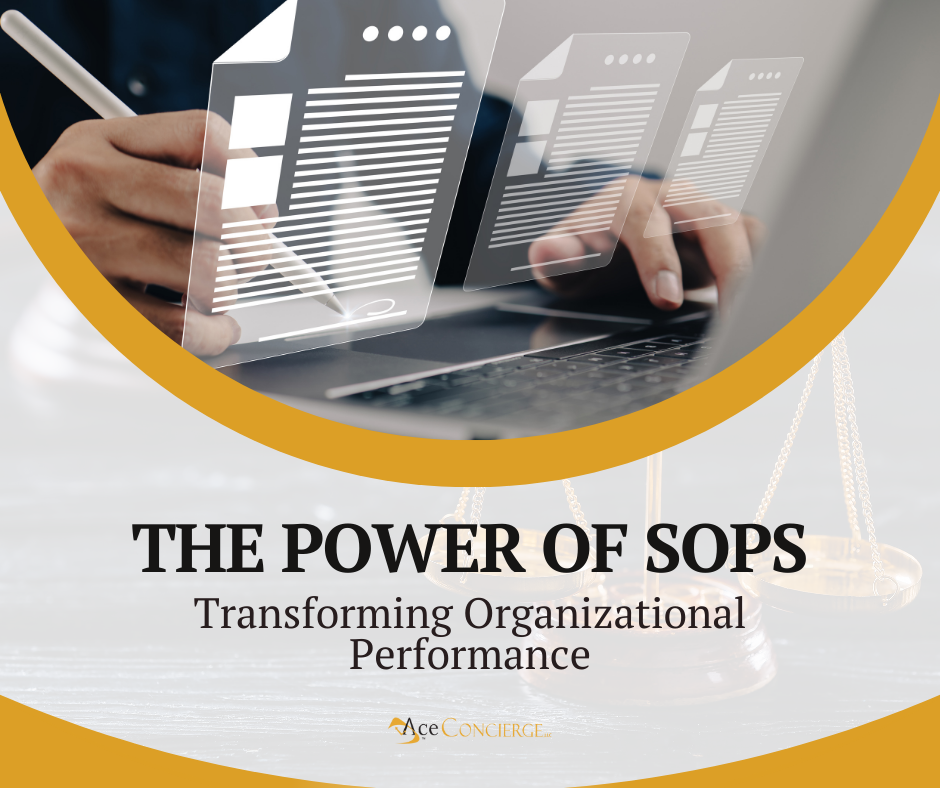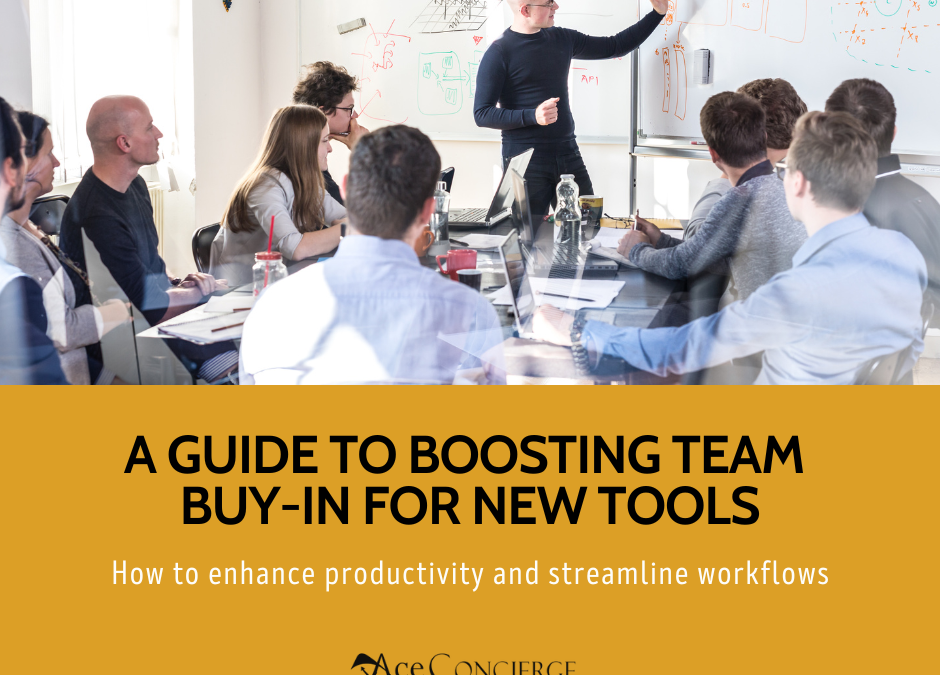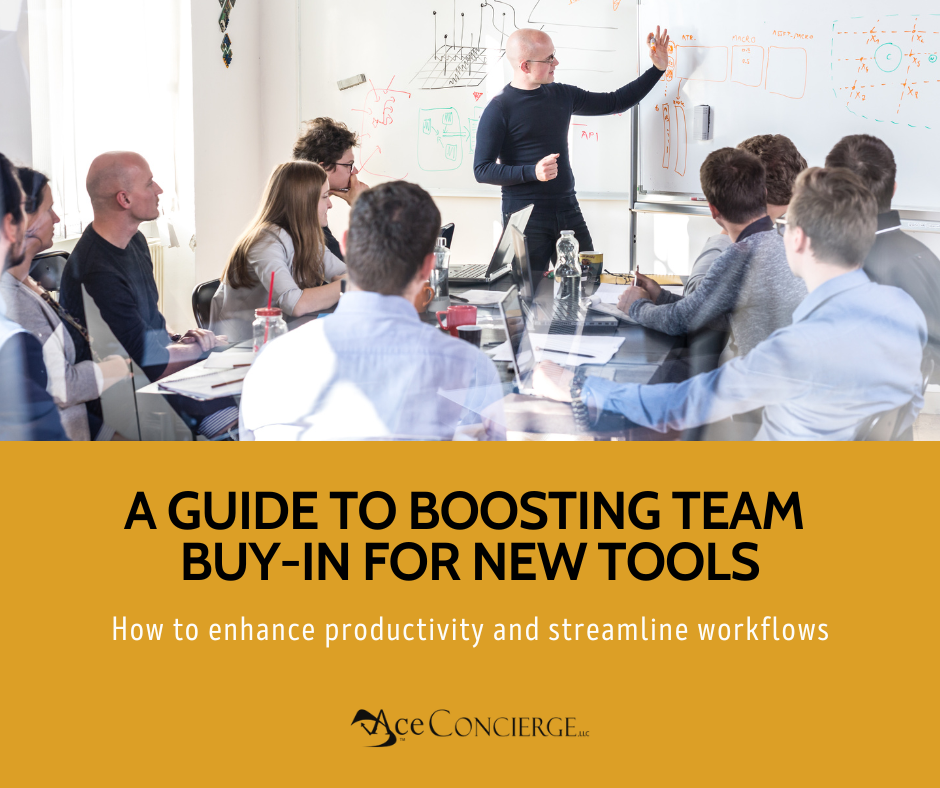
by Ace Concierge | Virtual Assistant | Jan 7, 2025 | Business Transformation, Leadership, Small Business

Organizations are always looking for ways to improve efficiency, uphold quality, and ensure consistency in their operations. One effective tool that has shown to be essential in reaching these objectives is the Standard Operating Procedure (SOP). SOPs are comprehensive, written guidelines describing how to carry out specific organizational tasks or processes.
The Strategic Value of Standardization
While SOPs may appear straightforward, their influence on operational effectiveness can be significant. They are strategic blueprints that capture institutional knowledge, optimize workflows, and create a foundation for consistent performance. Unlike generic instructions, well-crafted SOPs serve as living documents that evolve with organizational needs.
Additionally, SOPs can help identify bottlenecks and inefficiencies in existing processes. As procedures are documented and analyzed, organizations often uncover opportunities for improvement that may have been overlooked. Persistent enhancements can lead to substantial reductions in future time and costs.
Operational Efficiency: Beyond Simple Documentation
Consistency is a hallmark of successful organizations, and SOPs are crucial in maintaining it. By establishing standard procedures, companies can ensure that tasks are performed uniformly across different departments, shifts, or geographical locations. They provide:
- Clear, unambiguous task instructions
- Systematic approach to complex processes
- Reduction of human error
- Predictable performance metrics
- Scalable knowledge transfer
Training and Onboarding Reimagined
When joining an organization, new hires often face a steep learning curve, but well-crafted SOPs can ease this transition. By providing clear, step-by-step instructions for various tasks and processes, SOPs serve as valuable training tools that accelerate learning. They revolutionize this approach by:
- Creating structured learning pathways
- Reducing training time
- Ensuring uniform skill development
- Minimizing knowledge gaps
- Supporting continuous learning
Compliance and Risk Management
In many industries, regulatory compliance is a critical concern. SOPs are valuable tools for ensuring an organization’s processes align with industry regulations and standards. They:
- Demonstrate regulatory adherence
- Provide audit-ready documentation
- Establish clear accountability
- Mitigate potential legal and operational risks
- Create transparent performance standards
Knowledge Preservation and Continuity
Organizations often face challenges when key employees leave or retire, taking with them valuable institutional knowledge. SOPs help mitigate this risk by capturing critical information about processes and procedures. SOPs ensure:
- Preservation of critical processes
- Smooth leadership transitions
- Reduced dependency on individual expertise
- Consistent performance, regardless of personnel changes
- Systematic approach to organizational learning
Implementation Strategies
While the benefits of SOPs are clear, their effectiveness depends on proper implementation. Organizations should approach SOP development as an ongoing process, regularly reviewing and updating procedures to reflect technological changes, regulations, or best practices. SOP development requires:
- Cross-functional collaboration
- Regular review and refinement
- Employee engagement
- Leadership commitment
- Flexible, adaptable frameworks
Standard Operating Procedures are essential tools for organizations, serving not just as guidelines but as strategic frameworks that enhance performance and foster growth. By viewing SOPs as adaptable resources, companies can effectively turn challenges into opportunities for innovation and success.
Where there is no Standard there can be no Kaizen. Taiichi Ohno

by Ace Concierge | Virtual Assistant | Dec 23, 2024 | Delegation, Small Business, Work Life Balance

Every day begins with a rush—a barrage of emails, urgent requests, and endless tasks demanding your attention. Your mind is bombarded with responsibilities. Each task feels like a drop in a never-ending stream, filling your day with a sense of urgency and a constant need to react. There’s no room to breathe, no space to think beyond the next immediate crisis. It’s a cycle of perpetual motion with no clear destination in sight.
The demands are relentless. Meetings, emails, and client calls pull you in multiple directions, fragmenting your focus. Every interruption feels like an emergency, adding to the overwhelm. Each new task pulls you further away from what truly matters—your vision, long-term goals, and core genius. The more you try to keep up, the more you find yourself treading water, constantly struggling to stay afloat.
The urgent consumes your day, with little room for the important.
This isn’t just about managing tasks; it’s about managing your entire experience. The constant mental load of these demands can be exhausting, leaving you feeling disconnected and depleted. The pressure to stay on top of everything drains your energy, leaving you unable to find the clarity needed to make meaningful decisions. The more you juggle, the harder it becomes to see the wood for the trees.
You’re stuck in a reaction cycle, unable to break free.
Finding Clarity Amidst the Chaos
Overcoming this overwhelm starts with gaining clarity. It’s about understanding where your time is going and recognizing what truly matters to you and your business.
- What if you could identify and eliminate tasks that are merely distractions?
- What if you could automate routine activities?
- What if you could use systems to manage your workload and protect your mental space?
These changes free up significant time, allowing you to focus on what truly moves the needle for your business.
This shift isn’t about doing more; it’s about doing the right things. You can transform your experience from constant reaction to purposeful action by letting go of unnecessary tasks and distractions. It’s about reclaiming control over your time and energy, making each day an opportunity to achieve meaningful progress.
Instead of just surviving each day, you can thrive—seeing each challenge as an opportunity to grow and innovate.
Embracing a New Approach
To break free from the daily rush, you need a different mindset.
- Stop reacting to every demand and start protecting your focus.
- Set boundaries and learn to say no to distractions.
- Focus on what truly matters—not just the urgent.
You create space to think, plan, and grow by shifting your mindset.
By reclaiming your focus, you can transform overwhelm into empowerment. You move from merely surviving to actively shaping your day. Each task becomes a step toward achieving your goals. The more precise your path, the more control you have—moving from scattered chaos to purposeful clarity.
The key takeaway is that effectively managing time involves prioritizing essential tasks and eliminating distractions, leading to a more focused and intentional work life. Individuals can turn daily chaos into personal and professional growth opportunities by focusing on what truly matters.
Achieve more by doing less!

by Ace Concierge | Virtual Assistant | Dec 16, 2024 | Delegation, Executive Assistant, Virtual Assistant

Every CEO and entrepreneur knows the feeling: too many tasks, too little time. Days that stretch into nights, calendars jammed with back-to-back meetings, and a constant stream of emails demanding attention. The weight of it all is overwhelming. Yet, amidst this chaos, the most pressing question often goes unasked: Am I spending my time where it truly matters?
The hard truth is that most leaders aren’t.
In their drive to build, lead, and innovate, many executives fall into a dangerous trap—trying to do too much. Whether it’s a belief that no one else can do it better or the inertia of “I’ve always done it this way,” these habits prevent leaders from focusing on their core genius: the unique skills and vision that propel their businesses forward.
The High Cost of Low-Value Tasks
Consider this: how many hours of your day are consumed by tasks that could easily be handled by someone else? Reviewing reports, coordinating schedules, and responding to routine inquiries are essential, but are they the best use of your time? The answer is almost always no.
For high-performing leaders, every hour spent on low-value activities is stolen from strategic thinking, innovation, and growth. Worse, these tasks often erode energy and creativity, leaving little room for the kind of deep work that drives meaningful progress.
The opportunity cost is staggering. A 2020 Harvard Business Review study revealed that senior executives spend, on average, 23 hours per week in meetings—which doesn’t include email or administrative duties. Imagine redirecting just a fraction of that time toward high-impact initiatives. What could you achieve?
The Myth of “Doing It All”
Many leaders pride themselves on their work ethic and capacity to juggle multiple responsibilities. But the idea of “doing it all” is not only unsustainable—it’s counterproductive.
Here’s why:
- Burnout: Chronic stress and overwork diminish decision-making ability, creativity, and emotional intelligence.
- Bottlenecking: When everything flows through you, progress slows. Teams wait for approvals, decisions, and input that could be handled elsewhere.
- Missed Opportunities: Time spent on routine, low-value tasks means less time for making critical decisions that drive growth and innovation.
Delegation isn’t a luxury; it’s a necessity. The most successful leaders understand this. They know that their value lies not in managing the minutiae but in driving the vision and strategy that move their organizations forward.
Delegation Is a Superpower
Shifting from a “do-it-all” mindset to one of strategic delegation can be transformative. Delegation isn’t about offloading tasks but empowering others to take ownership, freeing you to focus on what you do best.
Here’s how to start:
- Audit Your Time: Spend a week tracking your activities. Identify tasks that are repetitive, administrative, or outside your core strengths. These are prime candidates for delegation.
- Prioritize by Impact: Separate your to-do list into high-payoff and low-payoff activities. High-payoff tasks align with your unique skills and organizational goals. Low-payoff tasks—scheduling, social media, admin tasks—are best handled by others.
- Build the Right Team: Effective delegation requires trust. Invest in team members or external support (such as virtual assistants) who excel in your delegating areas.
- Communicate Clearly: When delegating, be specific about expectations, deadlines, and desired outcomes. Clarity reduces the risk of miscommunication and ensures alignment.
- Let Go: This may be the most challenging part for many leaders. Delegation only works if you resist the urge to micromanage. Trust your team to deliver and focus on the bigger picture.
Unlocking the Multiplier Effect
When leaders delegate effectively, something remarkable happens their impact multiplies. Here’s why:
- Enhanced Focus: By eliminating distractions, you gain the mental clarity to tackle complex challenges and seize opportunities.
- Empowered Teams: Delegation isn’t just about you; it’s about building a culture of trust and accountability.
- Accelerated Growth: With more time to devote to strategic priorities, you can drive faster, more sustainable growth.
A client shared how they revolutionized their workweek by delegating scheduling and operational tasks to Ace Concierge. “I realized that the hours I spent coordinating meetings or handling routine emails were hours I wasn’t spending brainstorming new ideas or connecting with clients. Delegating these responsibilities wasn’t just freeing—it made me a better leader.”
The Delegation Mindset Shift
Delegation isn’t about admitting weakness or relinquishing control but maximizing impact. It’s about recognizing that your value as a leader isn’t measured by how much you do but by how much you enable.
The next time you find yourself drowning in low-payoff activities, pause and ask:
- Is this the best use of my time?
- Could someone else do this just as well (or better)?
- What would happen if I let go?
These questions are a compass guiding you back to what matters most.
Take the Leap
Time is your most precious resource. You can’t create more but can reclaim it by delegating strategically. Doing so isn’t just a practical choice; it’s a profound act of leadership.
Imagine what’s possible when your time is fully aligned with your genius. Picture a workweek where you’re energized, focused, and driving meaningful impact. That vision isn’t a distant dream; it’s a choice that begins with delegation.
“The first rule of management is delegation. Don’t try and do everything yourself because you can’t.” Anthea Turner

by Ace Concierge | Virtual Assistant | Dec 1, 2024 | Goals, Life Thoughts

Traditionally, the end of the year brings about a time for renewal and reflection. What worked, what didn’t, where can you improve, and how will you set the world on fire next year? Isn’t it exciting to think of everything you’d like to accomplish?
New directions and goals.
Start fresh and put the past in the past.
Your resolutions fly off the tongue. You are inspired and driven for change. It’ll be the best year ever. Right? Does this sound familiar?
Studies have shown that less than 25% of people are successful at staying committed to their resolutions after 30 days.
Why are resolutions shelved for the END of the year?
You are a work in progress. Constantly evolving, growing, changing, like a chameleon.
Instead of New Year’s Resolutions, consider goals: daily, weekly, monthly, and yearly. Alongside the goals, you can establish habits that are long-lasting and life-changing.
90% of resolutions often fail after two short months. One possible reason is willpower. You know you have it. You’ve tested it, but how long does your iron fist (if necessary) keep on target with your goals? Willpower can be a tricky mind game.
Willpower, like a bicep, can only exert itself so long before it gives out; it’s an extremely limited mental resource. Jonah Lehrer
Why do resolutions fail?
- Overzealous ideas
- Taking on too much
- Lack of real desire for change
- Minimal effort
- Adopting someone else’s resolutions
- It’s something you think you should do, rather than want to do
- Quitting too early
Sure, you had admirable intentions and passion for change but when it is a once-a-year review, it is more challenging to persevere.
An overnight quick fix is not the solution. This mindset is transactional, not transformational. Transformation involves ongoing introspection, discovery, pivots, and corrections.
Create habits and rituals that are indestructible commitments to yourself, your business, or your life.
A prime example is exercise and a gym membership. Enthusiasts show up every January ready to pump iron and sweat it out until they hit their lofty goals. By the end of the first month, most of those once motivated gym-goers are long gone. By February, you’ll typically find only those who have made fitness a lifestyle.
You might be sick and tired of some things in your life or your business, but when you make “resolutions” out of desperation and frustration, they are more challenging to maintain. You may deeply want them. You may feel passionate about change and be ready to execute but think seriously about what you want and why.
Change is ongoing, not a fleeting thought to revisit once a year.
How can you guarantee greater success?
- Start small
- Tie your goal to a habit
- Write down your goals WITH action steps
- Think: S.M.A.R.T. Goals: specific, measurable, achievable, realistic, and timely
- Be realistic, not too grandiose
- Make a vision board
- Inspire and motivate yourself
- Celebrate your successes – no matter how large or small
- Be accountable
- Involve others
- Understand you will have ups and downs (that’s okay)
- Realize change takes energy
- Failure is acceptable because you will try again
- Have a plan for your perceived roadblocks
- If you want different results, change the experiment
- Changing or modifying a behavior takes time
- YOU do have time
- Dump the inner critic!!
- When in doubt, ask yourself: “How does this serve my goals?”
- Work on yourself ALL year, not just at the end
Are you ready to create new yearlong habits or New Year’s Resolutions?
Remember this: YOU are the architect of your life. Build your vision.

by Ace Concierge | Virtual Assistant | Aug 27, 2024 | Small Business, Technology, Toolbox, Uncategorized

Introducing new tools and technologies is a constant in today’s workplace. However, successfully adopting these tools often depends on how well employees are educated, which is crucial for gaining team buy-in and boosting efficiency.
The Importance of Education for New Tools
The primary reason for introducing new technology is to enhance productivity and streamline workflows. However, employees who are not adequately trained may resist change, leading to decreased morale and productivity. Educating employees empowers them to use the tools effectively and fosters a culture of continuous improvement and adaptability.
- Boosts Confidence and Competence: Employees who are well-informed about new tools feel more confident and capable in their jobs. This newfound confidence leads to greater efficiency, allowing them to complete their tasks more quickly and accurately.
- Reduces Resistance to Change: Much resistance to change comes from a fear of the unknown. Thorough education, clear instructions, and demonstrations of the new tech stack, real benefits can alleviate these fears, making the transition smoother.
- Maximizes ROI: Companies put a lot of resources into acquiring new tools. Ensuring that employees are adequately educated on using these tools allows them to be utilized to their fullest potential, maximizing the return on investment.
Common Pain Points
Even with the best intentions, educating employees on new tools can face several challenges.
- Information Overload: Employees might feel inundated by the volume of new information they need to take in, which can lead to disengagement.
- Lack of Personalization: A generic approach to training can fall short. Different team members possess varying levels of technical skills and learning styles.
- Insufficient Follow-Up: Initial training sessions often aren’t enough. Employees may forget what they’ve learned without ongoing support and reinforcement and revert to old habits.
- Technical Difficulties: New tools can introduce their technical challenges. Without proper troubleshooting assistance, employees may encounter issues that disrupt their workflow.
- Resistance to Change: Employees might resist new tools due to fear of the unknown or prefer established processes. This resistance can significantly hinder successful tool adoption.
- Lack of Understanding: Without adequate training, employees may find it difficult to use new tools effectively, resulting in frustration and reduced productivity.
Strategies for Educating Employees
To tackle these challenges and ensure a smooth implementation, consider the following strategies:
- Conduct a Needs Assessment: Before introducing a new tool, it’s essential to assess the current challenges and determine how the new tool can help. This will allow you to customize the education process to address specific needs.
- Engage Leadership: It is essential to gain support from leadership. When leaders actively participate in the training and commit to the new tools, they set a positive example for the rest of the team.
- Develop Comprehensive Training Programs: Design detailed yet easy-to-understand training programs. Use various formats, such as workshops, webinars, video tutorials, and written guides, to accommodate different learning preferences.
- Incorporate Hands-On Practice: Provide employees with the opportunity to practice using the new tools in a safe environment. This practical experience can significantly improve their understanding and retention.
- Provide Ongoing Support: Create a support system for employees to seek assistance. This could involve a dedicated helpdesk, regular Q&A sessions, and access to a knowledge base.
- Gather Feedback and Iterate: Solicit employee feedback regarding the training process and the usability of the new tech platforms. Use this input to make necessary adjustments and enhancements.
- Celebrate Milestones and Successes: Recognize when teams adopt and use new tools. This not only boosts morale but also reinforces the importance of the new tools.
Teaching employees about new tools goes beyond simply sharing information; it’s about creating an environment that values learning and flexibility. By tackling common challenges and adopting effective training methods, companies can help their teams become skilled in using new tools and excited about what they can achieve. This approach boosts efficiency, enhances morale, and cultivates a more adaptable and resilient workforce. It’s important to remember that the foundation of successful tool adoption is ongoing education, support, and recognition of achievements.










